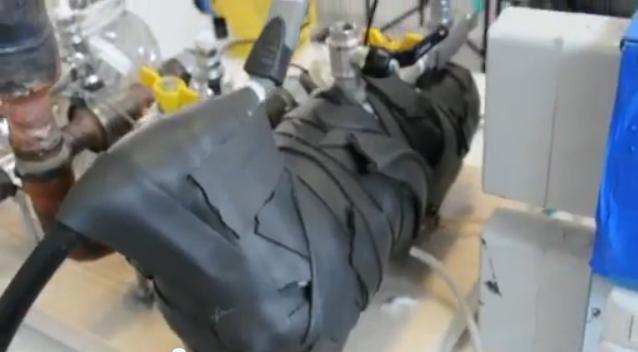
Mats Lewan |
Mats Lewan, the technology journalist with Ny Teknik who was by far the biggest promoter of Andrea Rossi and his Energy Catalyzer, knew that the water Rossi fed into the E-Cat didn't produce the extraordinary amount of steam it should have if Rossi's claim was valid. Lewan also had a good idea about where the rest of the water went. He reported neither of these concerns to his readers.
According to Rossi's claim, the E-Cat should have produced 11,200 liters of steam per hour. Steam should have blasted out through the black hose at 60 to 100 miles per hour. It didn't even come close. Lewan has a master’s degree in engineering physics; he should have known how much steam to expect. |
Other visitors to Rossi's showroom did not know how much steam should have come out of Rossi's E-Cat and the rate at which it should have come out. They saw some light puffs of steam and went away happy. But as Mitch Randall, an accomplished U.S. inventor, showed in the New Energy Times article "Proof of Rossi’s Deception," Rossi manipulated the E-Cat to produce even this trivial amount of steam.
There was no outlet directly on the E-Cat that vented the steam when Lewan saw it. Instead, there was a black hose connected to the outlet which ran into an adjacent room. This hose then went into either a blue plastic bucket or a drain hole in the wall.

Rossi's "Energy Catalyzer," wrapped in insulating rubber, outlet hose on left. Source: Lewan's video
In an e-mail on June 8, 2011, Lewan told Randall that he knew that the steam flow was weak.
"This is a thing many people have noticed in [my] video and asked me about," Lewan wrote, "The easy answer is that I checked the steam flow continuously during the test, not only during the video take, and the behavior was very similar all the time. It seemed calm [when the hose was] down under water and increased when [I pulled] the tube [up and it] reached the surface.
"The steam flow actually appeared weak also to me, fluctuating depending on how deep down the tube was immersed in the condensed water in the bucket."
Lewan noticed that, each time he walked out of the room where Rossi was with his E-Cat and he went into the adjacent room to look at the end of the hose which was sitting in two or three inches of water in the blue bucket, the steam began to appear more obvious.

"Steam" runs from black hose into blue bucket. Source: Lewan's video
Two months later, New Energy Times published "Report #3: Scientific Analysis of Rossi, Focardi
and Levi Claims," which included multiple calculations by several engineers and scientists that showed that the weak steam flow proved that the E-Cat didn't work as Rossi's claimed.
Lewan also realized that unvaporized water, rather than just steam, could be flowing out of the E-Cat and down through the black hose, as he wrote to Randall on Aug. 28, 2011. If Rossi were sending any unvaporized water down the black hose, it would invalidate his claim.
"It seems that my method for verifying that there's no liquid water at the outlet is not very accurate. I'll have to investigate this further," Lewan wrote.
Lewan's concern about liquid water flowing out of the outlet is precisely the concern that NASA engineer Michael Nelson recognized in June 2011 as the easiest and most obvious way that Rossi could be creating a deception.
Not only did Lewan fail to report to his readers his crucial concern, but he also apparently failed to investigate it further.
On March 14, New Energy Times sent Lewan and Norbert Andersson, the editor-in-chief of Ny Teknik, an e-mail. We asked Lewan whether he investigated this further and, if so, what he found.
Lewan did not respond.
|

